Iconic brands like Gucci, Starbucks, and Nike have one thing in common—they all recognize the value of NFTs (and NFT localization) in building global brand communities.
But fret not if you don’t have the resources of major companies, because building a thriving global NFT community has never been more accessible. There are several ways you can tap into the power of localization to reach new audiences and transcend borders, bringing your project to the global stage.
Let’s dive into the rapidly growing world of NFT-powered communities.
In this in-depth guide, you will find out:
- Why community is so important in the Web3 era
- Why you would want to build a global NFT community
- Why NFT projects need localization
- Examples of successful global NFT communities
- What you can miss out on by not localizing your NFT project
- 5 actionable steps to building a global NFT community
Why is community so important in the Web 3.0 era?
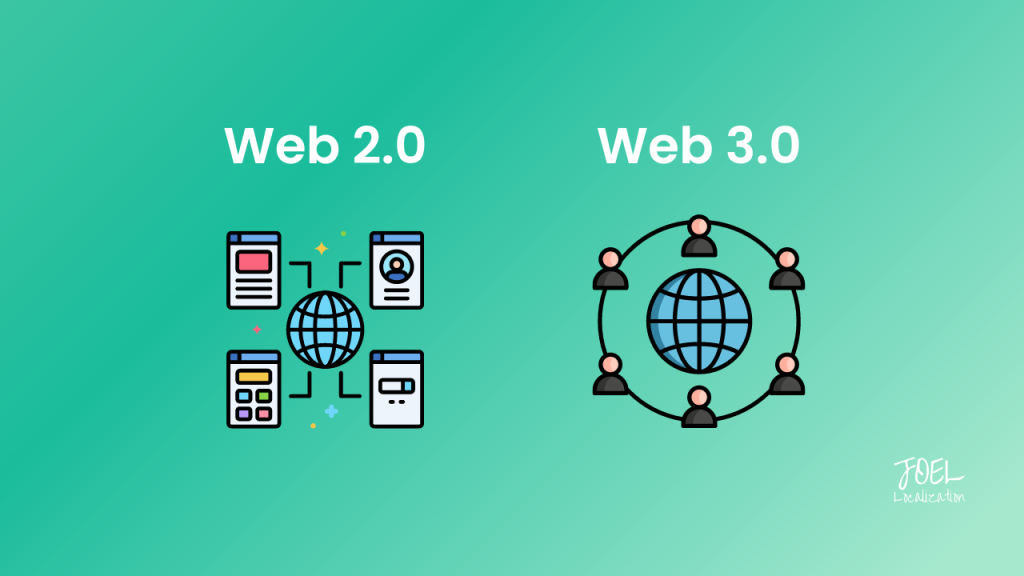
The days of the big, centralized platforms of the Web 2.0 era are slowly coming to a close.
Web 3.0 is all about creating a more decentralized, intelligent, and user-centric internet, where individuals have more control over their digital lives and interactions. This allows for greater security, privacy, transparency, and ownership, as well as the creation of new types of applications and platforms.
That brings us to NFTs, the unique digital assets that can represent anything from art to music to virtual real estate, and the communities that have been built around them. Blockchain allows individuals to trade NFTs with each other directly without the need for intermediaries or centralized platforms.
With a sales volume that soared to $18.5 billion in 2021—570 times more than that of the year before—NFTs are a part of the broader trend of decentralization and disintermediation in the Web 3.0 space. Although it may have slowed down last year due to the recession, the market is expected to reach a growth rate of 27.3% by 2027.
The value of an NFT is often derived from the community that supports it—not to mention its exclusivity of it, which is a key aspect that both drives demand for NFTs and instills a sense of belonging among the people that trade them.
What is an NFT community?
An NFT community is a group of individuals who share a common interest in NFTs, and come together to support a specific NFT project or group of projects. These communities are typically online groups with limited membership, and members gain access by acquiring an NFT from the group’s collection.
The NFTs within these communities serve as a digital key that can grant access to exclusive opportunities, such as play-to-earn games, sub-communities, staking, and investment opportunities.
At their core, NFT communities are gatherings of NFT brands, their buyers, and their most dedicated fans.
Why build a global NFT community?
NFTs offer unique prospects for creators to monetize their digital creations and for collectors to invest in and own distinct digital assets. The same is true whether you are in Canada, Brazil, or South Korea. The market is there for new, international opportunities—you just need to capitalize on it.
By bringing your NFT venture to the global stage through a dedicated community (and, of course, a carefully crafted localization strategy), you can:
- Promote and display your work.
- Collaborate with other talents in the Web3 space.
- Facilitate the widespread adoption and growth of NFTs.
- Monetize your content directly to a community of high-intent buyers (loyal fans and NFT investors).
- Increase the visibility of NFTs as a legitimate asset type.
- Promote diversity and inclusion in the NFT space by bringing together creators and collectors from different backgrounds and cultures.
- Help establish international standards and best practices for NFT creation, distribution, and ownership.
- Create a more vibrant and sustainable ecosystem for digital art and collectibles, with new opportunities for creators, collectors, and investors alike.
As Web3 transforms how people communicate with each other online, decentralized communities are the way forward to reach new levels of global adoption.
But to get there, you need localization.
Why do NFT projects need localization?
English may very well be the lingua franca, but appealing to new audiences by adapting your community, content, and software infrastructure to local languages is as important as it ever was in the Web 3.0 era.
Here are some of the benefits of NFT localization.
- It allows creators to target specific audiences and cater to local preferences. Particularly relevant in the art world, where cultural and linguistic differences can greatly impact the value and appeal of a piece of artwork. Through localization, creators can sell NFTs in different regions with varying currencies and modes of payment, which enables access to new markets and revenue streams.
- It increases the accessibility of NFTs. Language barriers can be a significant obstacle to the adoption of new technologies and services. By localizing NFTs, creators can provide content in the local language, which can increase the accessibility and adoption of their NFTs in different regions.
- It allows you to get ahead of the curve. Web 3.0 technology and infrastructure are still in the infancy stages. They are also heavily dominated by English. In the coming years, however, the demand for multilingual accessibility in blockchain technology will reach new heights—and your company will do well to get ahead of the curve by translating your content and building a global community before everyone else does.
- It can help promote and maintain local art and culture to the wider world. By creating NFTs for works of art that are based on or inspired by local culture, artists and creators can make these works available to a global audience, allowing people from all over the world to appreciate and learn about different cultures. In doing so, artists and creators can also generate support and funding for their communities. This can help support local artists and cultural institutions, and promote the continued creation and preservation of local art and culture.
As Web 3 reduces the reliance on centralized platforms, it provides fairness and ownership for creators and collectors. But, at the same time, it also means that both creators and companies will need to invest in translations directly to market their creations to a broader audience.
Managing localization projects takes up a lot of time and effort for companies that are already strapped for resources—which is why many turn to specialized localization agencies like JOEL Localization to handle every part of the process from end to end.
NFT localization examples: Case studies of global NFT projects and communities
1. CryptoKitties NFT Localization
The CryptoKitties game NFTs have become popular in Japan, a country with a strong culture for gaming and collectibles (great combination, right?)
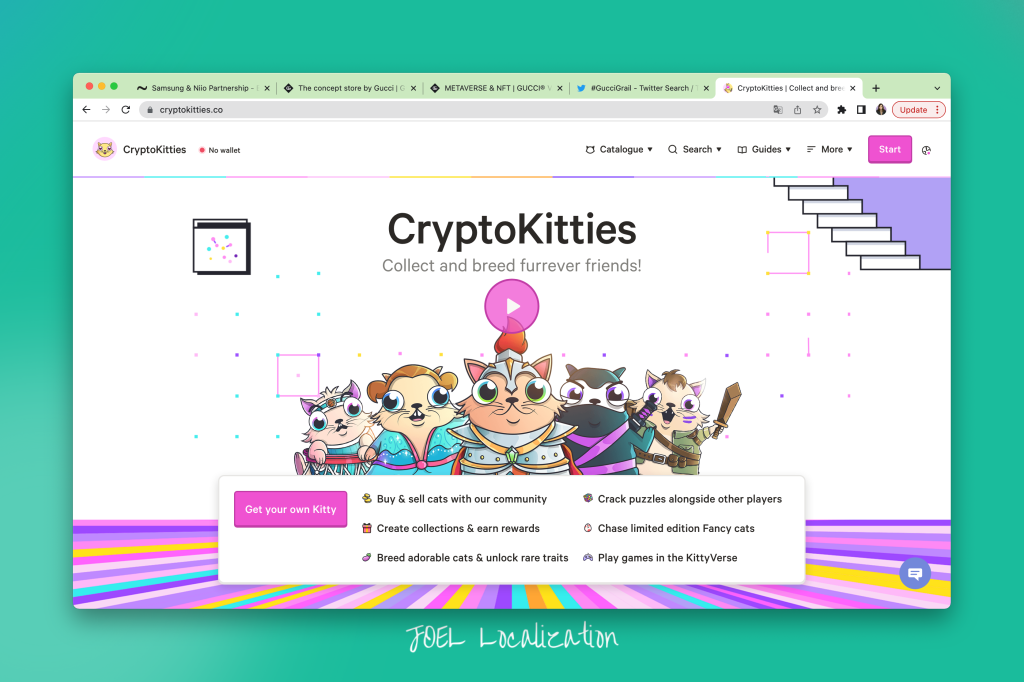
The creator, DapperLabs, reached the local audience by partnering with Coincheck, the leading cryptocurrency exchange in Japan. The partnership had the goal of making NFT assets mainstream and accessible to people in the country.
In another interesting turn of events showcasing the cross-border accessibility of NFTs, CryptoKitties has also collaborated with the Japanese blockchain game developer, Crypt-Oink. Talk about blockchain interop!
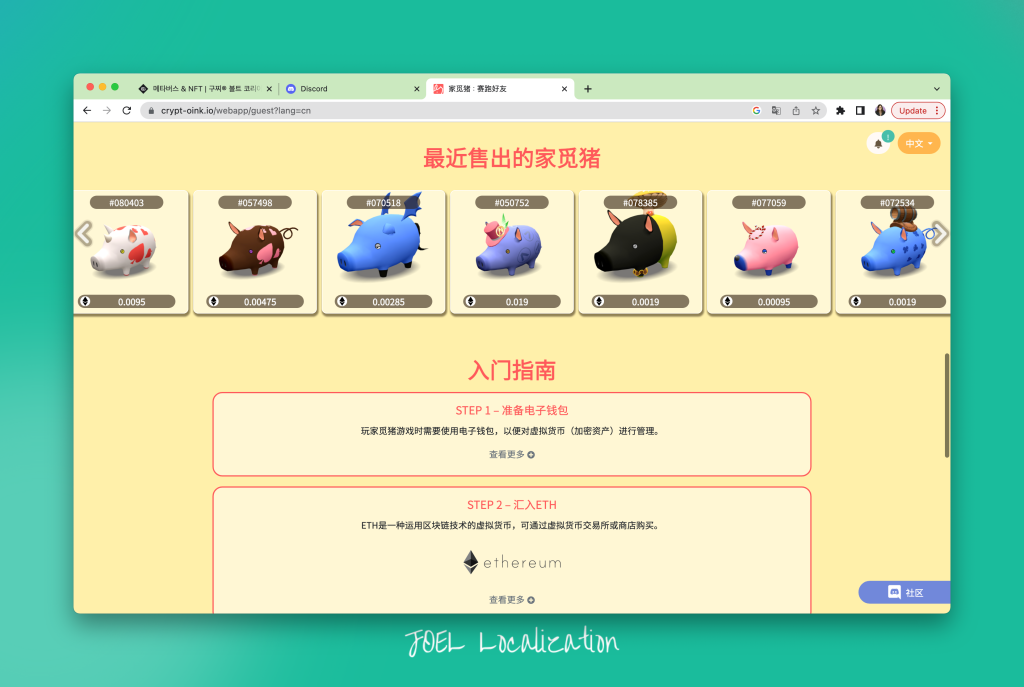
Of course, the NFT developer’s global outreach also extends to the community. Fans of CryptoKitties gather in a dedicated global NFT discord community with 80,000+ members and dedicated channels for local languages (including Russian, Chinese, Spanish, Japanese, and Korean).
2. Gucci NFT Localization
In 2021, Gucci became the first luxury brand to launch NFTs as part of its venture into the metaverse and Web3 technologies.
#GucciVault, the House’s new online concept store is many different things at once: a time machine, an archive, a library, a laboratory, and a meeting place. #MFW #GucciVault #AlessandroMichele pic.twitter.com/gjyT5Rv39X
— gucci (@gucci) September 25, 2021
When launching Gucci Vault—essentially, an online concept store with NFT collections—the brand referred to it, among many other things, as “a meeting place.”
To appeal to global audiences, Gucci localized the website for the Vault into several different languages, as seen in Korean below.
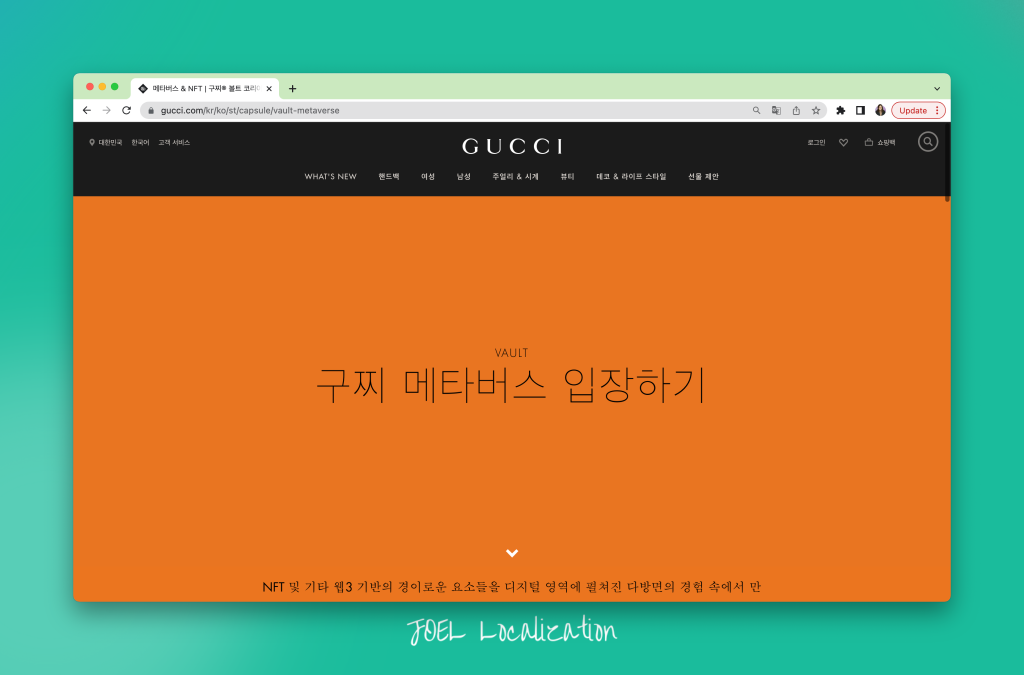
Similar to CryptoKitties, and “in line with the house’s spirit of community,” Gucci operates a 20,000+ member-strong Discord community that brings together Gucci NFT holders from all over the world.
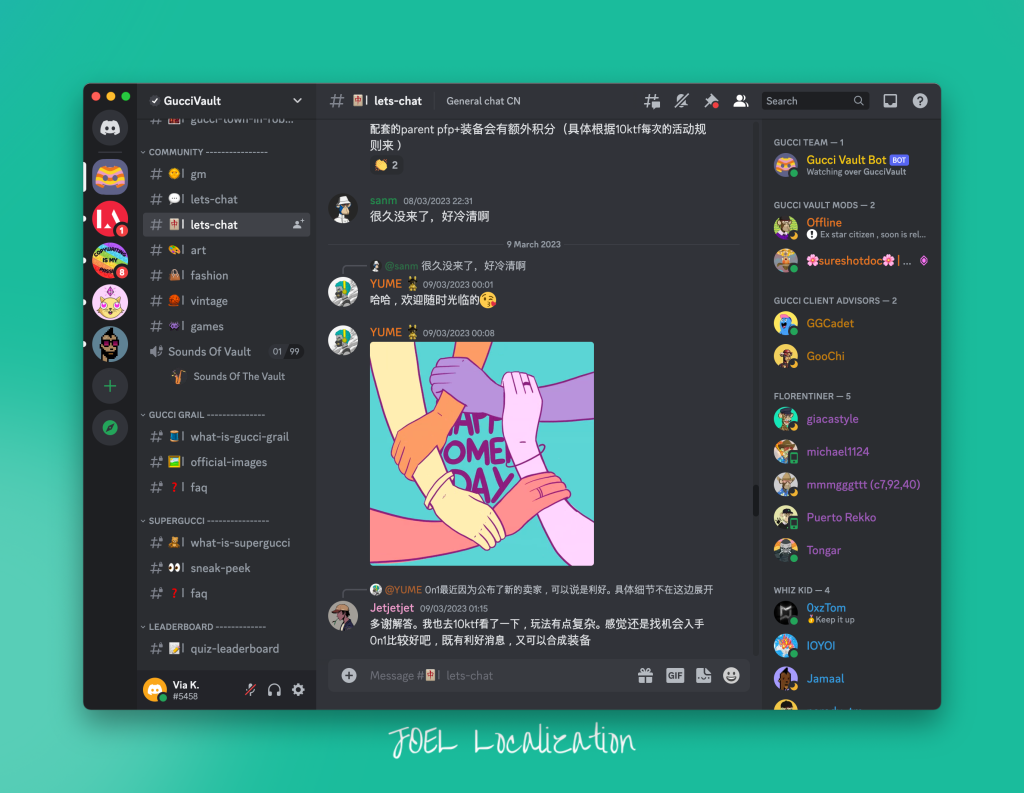
Bar none, Gucci’s venture into NFTs has been a huge success in terms of building fan engagement and loyalty through community building.
Owning a Gucci NFT has become a badge of pride and unity that brings people together across time and space, showcasing how Web3 communities are crafting engaging customer experiences and creating opportunities for brands to capitalize on new technology.
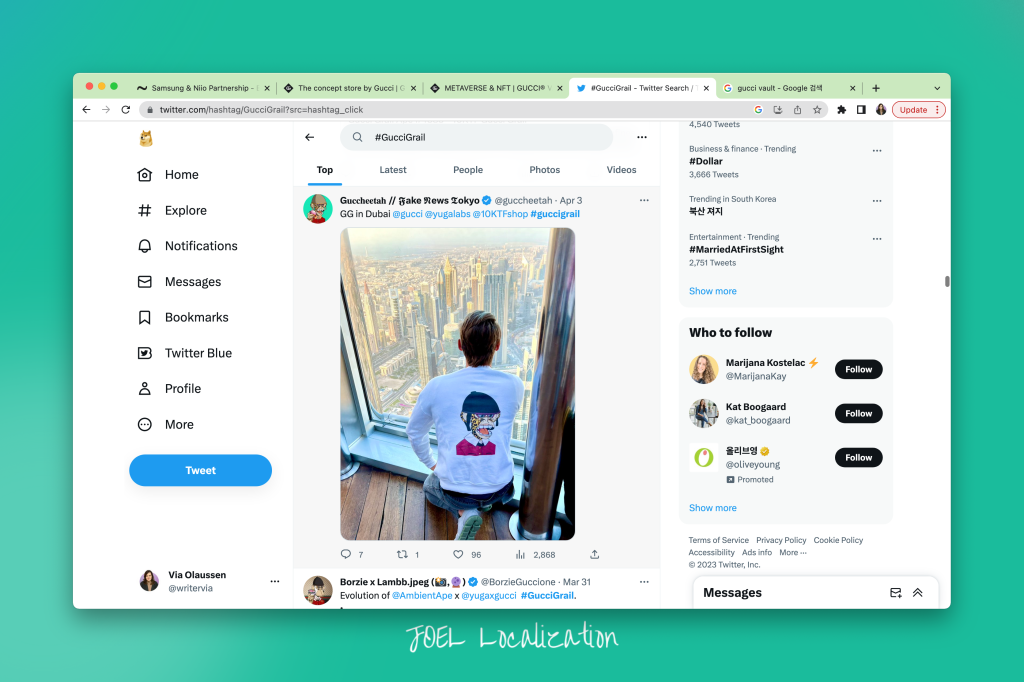
The brand has a lot to thank for its global NFT success, including its incredible reputation for quality built over 100 years.
But, NFT translation and localization also had a huge role to play in building affinity for the brand and manifesting its global reach in the space.
Let’s find out how you can do the same.
5 steps to building a global NFT community
What can you learn from NFT localization success stories? More importantly—how can you translate these learnings into an actionable global community strategy for your brand or company?
Here are five main steps.
1. Identify your target markets and audiences
Finding your community’s objective and conducting thorough market research will help you identify the right target markets for your global NFT venture.
- Conduct market research to identify potential NFT fans and collectors.
- Analyze the demographics, interests, and behaviors of your ideal community.
- Narrow down your target audience (it is best to be as specific as possible to provide the most value).
- Consider cultural, political, economical, and technological factors.
- Refine your business strategy using data-driven insights.
- Tailor your community-building efforts accordingly.
Branding and engagement strategies should appeal to the identified target markets and be based on the local language and culture.
Always remain flexible, adaptable, and updated with trends, as the NFT landscape is constantly developing. Your priority should be to make sure your community management remains relevant to your target markets and aligned with your global brand marketing goals.
👉 TIP: Lack of access to data is often a challenge when identifying potential target markets for NFTs. Do you have an existing group of followers and buyers interested in your work? If so, do you know where they are from? To find out, you may either use the internal metrics offered on your existing platforms like Twitter, YouTube, Instagram, Discord, or b.stage. Another option is to follow news from NFT-related websites like nft now, NTF News Today, or NFT Plazas to identify markets with the biggest opportunities for entry.
2. Find the most suitable platform to host your community
Many NFT communities are on Discord, which is a great platform for building a community in the Web3 space.
However, as with anything, consider which platform has the biggest rate of adoption in your chosen target market and with your target audience (especially in terms of support for various languages).
Whichever platform you chose, these steps will help you build a strong community:
- State your community’s objectives.
- Create clear rules.
- Establish a welcoming atmosphere by fostering positive interactions and addressing confrontations.
- Provide regular and compelling content, such as events, announcements, and discussions to ensure member engagement.
- Interact with your community consistently.
- Promote your community through social media, partnerships, and word-of-mouth to draw new members and maintain growth.
👉 TIP: Another solution you should consider is b.stage, a platform builder that allows you to build your own channel with all the necessary features for an NFT community in one place.
3. Develop an NFT localization strategy
At this point in the process, you should consider how you will adapt your art and marketing messages to the specific locales.
NFT localization is a constantly evolving process that involves:
- Translating NFT-related website copy and content.
- Collaborating with local influencers.
- Adapting marketing campaigns and social media content.
- Considering local payment methods and legal regulations.
- Integrating online and offline experiences through events.
- Providing local customer support.
- Continuously monitoring and adapting the localization strategy based on feedback and metrics.
👉 TIP: Localization requires working closely with carefully chosen local partners or agencies to produce culturally relevant and linguistically sound content, all the while maintaining the authenticity of your brand image. We’re not tooting our own horn at all. Still, we’d say that your best bet is to find an agency like JOEL Localization that specializes in Web3 technology—and also takes care of the nitty-gritty of managing the entire project for you.
4. Seek out local communities in the Web3 space
Social media platforms, NFT forums, Discord groups, and local events can do wonders for you if you engage with them in the right manner. Participating consistently in discussions and providing value at every turn will help you establish yourself as a reliable source and contribute positively to the NFT ecosystem.
For developing trust with NFT communities, the most important thing is to:
- Be transparent in your intent.
- Create value through unique and meaningful NFTs.
- Share and engage with NFT-related content by liking, commenting, and retweeting.
- Use NFT groups, forums, and chats to partake in discussions and ask questions.
👉 TIP: Collaborating with local artists or groups to build awareness and offer value through content (while maintaining the integrity of your brand image). To increase your reach, use relevant hashtags when you post NFT-related content to increase visibility. Never indulge in spamming or self-promotion. Instead, focus on genuine interactions and adding value to the community.
5. Actively listen to your members
Active engagement and careful listening are the two most important elements of building a strong NFT community. Valuing the feedback, concerns, and suggestions of the community members plays a vital role in assessing their needs.
Through active engagement and listening, you can gain insights into the desires, anticipations, and challenges faced by your NFT community members.
You can use this information to bring necessary changes to your services, come up with completely new ideas, and develop your strategy as you go along.
Remember to:
- Actively listen and respond to community feedback.
- Providing quality experiences.
- Be fair in distribution and decision-making processes.
- Be empathetic towards community members’ viewpoints and worries.
👉 TIP: Conducting surveys, polls, and interviews with members can also provide beneficial responses, letting you know about their priorities and thoughts.
Take your NFTs to the global stage with JOEL Localization
Our linguists have years of experience in the industry, advanced degrees, and niche expertise in the Web3 space. If you work with us, you can stop worrying about planning and managing your localization project—and focus on creating amazing NFTs that can go to market with ease.
Email our production team now for a quote: production@joellocalization.com
